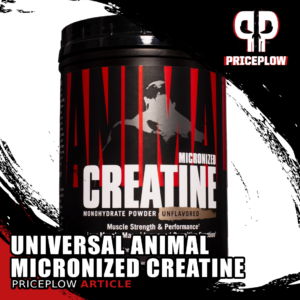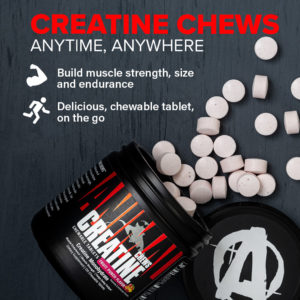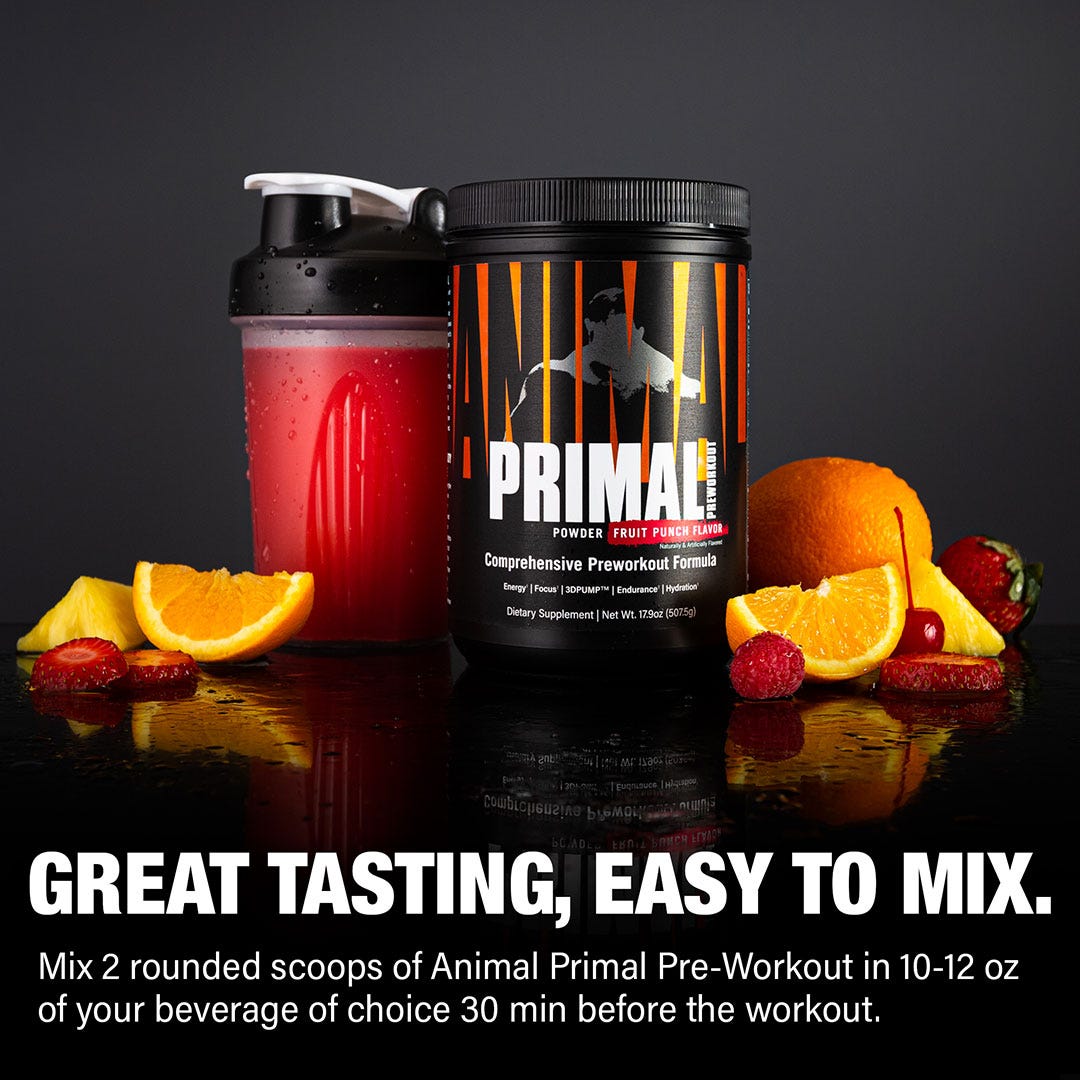Whey protein and creatine: the twin pillars of modern sports supplementation. If you're here with us on the Priceplow Blog, there's a zero-percent chance you haven't heard of creatine, and only a slightly larger chance that you've never taken it. You may even think you know everything there is to know about the compound.

Creatine has a tsunami of research touting its efficacy in increasing athletic performance and even muscle gain.
Well creatine isn't played out. It's king for a reason. Research continues to find more and more evidence for the benefits we already know about in regard to creatine usage, and brand new benefits entirely.
The amount of research supporting the efficacy of creatine is mind-boggling. Today, we're going to focus on Universal's Animal Micronized Creatine Monohydrate, and its benefits as it relates to muscle growth, in particular.
The third recent creatine release in Team Animal's arsenal
This is a follow-up supplement to two phenomenal creatine releases from Team Animal at Universal Nutrition, the tasty Animal Creatine Chews and the supercharged Animal Creatine XL. We loved those two products -- and both for very different reasons -- but sometimes, you just want some... plain creatine monohydrate!
This makes it a perfect supplement to combine with Universal's incredible new pre-workout supplement, Animal Primal, which has several other ergogenic ingredients except creatine, allowing you to take it pre or post-workout.
In this article, we dig into the benefits of creatine, focusing on muscle gains. This is from Animal, after all. First, let's check on prices, availability, and get you signed up for our our Universal Nutrition alerts:
Universal Animal 100% Pure Creatine Monohydrate – Deals and Price Drop Alerts
Get Price Alerts
No spam, no scams.
Disclosure: PricePlow relies on pricing from stores with which we have a business relationship. We work hard to keep pricing current, but you may find a better offer.
Posts are sponsored in part by the retailers and/or brands listed on this page.
This area is reserved for Team PricePlow's upcoming videos.
Subscribe to our channel and sign up for notifications so you catch it when it goes live!
Why should you take creatine?

One thing and one thing only - 5 grams of tried-and-true creatine monohydrate in Universal's Animal Creatine
Like we said, we're primarily going to focus on muscle-growth benefits, but let's go through a quick rundown of the many other benefits that creatine has been shown to provide:
- Increased muscular power[1,2]
- Faster lean mass gain[2-6]
- Increased cellular hydration[7]
- Improvement in sprints and high-intensity activities[8-10]
- Increased energy[11-14]
- Better mood[14-16]
- Improved cognitive performance[17,18]
People are always looking for that wonder supplement, and creatine comes closest in a plethora of areas and health goals.
How does creatine work?
The key to creatine's method of action is adenosine triphosphate, or ATP. The production of ATP is the body's key metabolic function – ATP is the energy that powers every other function.

A study published in 2011 does a fantastic job showing creatine's role in the production of ATP in the mitochondria.[19]
The chemical precursor to ATP is ADP, or adenosine di-phosphate. For readers familiar with either chemistry or latin, it's clear from ADP's name that it differs from ATP by one phosphate group. In order for ADP to be turned into ATP, that extra phosphate group has to come from somewhere.Enter creatine. Creatine acts as a phosphate donor – it delivers phosphate groups to your mitochondria, allowing for the conversion from ADP to ATP to take place, and for your body to make the energy it needs to function at a high level.[20]ATP is universal on a cellular level. While the primary uses of creatine have been focused around athletic performance, every cell in the body utilizes ATP, including brain cells. Creatine has a bevy of research behind it suggesting numerous cognitive benefits, in addition to the more well-known physical benefits.[21]
Creatine in the diet
Creatine is found in the typical person's diet to a certain degree. It's most commonly found in beef, which contains between 2 and 2.5 grams of creatine per pound.[22] Unless you're a strict vegetarian, you're probably getting some creatine through your diet.

Introducing Animal Beef Biltong from Universal Nutrition! If you haven't researched biltong, now's your chance. This stuff is unreal, and will provide a dash of creatine in its own right.
Here's the thing, though, the average man loses between 1.6% and 1.7% of his total creatine stores each day, which works out to roughly 2 grams.[23,24] So unless you're eating more than a pound of red meat per day, you're just breaking even — at best.
Enter creatine supplementation. In order to keep creatine stores topped-up and creating ATP, creatine supplementation has been found to be effective, and you don't have to eat three pounds of beef per day to get there.
How to take creatine
Creatine supplementation is often split into two stages of dosages. In the first stage, referred to as creatine loading, the goal is to quickly saturate your cells with creatine. In this stage, the industry standard is to take up to 20 grams of creatine per day for 5 to 7 days.
After that first week or so of creatine loading, a standard daily dose of 5 grams per day is sufficient for making sure your body has all the creatine it needs.
Creatine effects on muscle growth
The most common use case for creatine supplementation is to support muscle growth and body recomposition. This is for good reason – it works.

For a more on-the-go (and tasty) delivery method, try out Universal's Animal Creatine Chews!
The body can only store enough ATP for roughly 8 to 10 seconds of high intensity exercise.[25] When it runs out, it has to create more. The body does this by utilizing creatine to turn ADP into ATP, as stated above. Therefore, creatine supplementation can allow you to exercise more intensely for a greater period of time than you would typically be able to handle.
Creatine's hypertrophy benefits derive from its impact on the amount and intensity of work (energy output) your body can handle during exercise. Creatine has been demonstrated to increase max power output, increase the number of reps performed during high-intensity sprinting workouts, increase total work performed, and increase performance during a single maximum-effort sprint. Creatine improved each of these metrics by between 5 and 15%.[26]
Research has consistently demonstrated that people who work out with the help of creatine can double lean muscle mass gains as compared to those who don't. One study in particular showed improvement across the board in collegiate football players that used creatine for 5 weeks. The creatine group drastically outperformed the control group in increases in lean body mass, as well as overall performance gains.[27-30]

Great tasting, easy to mix, and fierce workouts - Animal Primal is a loaded pre-workout with novel new ingredients to try - but zero creatine, making it perfectly stackable with Animal's Micronized Creatine here!
More work and an increased rate of work equates to more intensity, and creatine allows you to train harder, for longer. The consensus in the nutritional-health industry is that this increase in ATP production, and therefore intensity, is the primary push behind creatine-driven hypertrophy.
Conclusion: Creatine is a no-brainer
In the sports supplement industry, new things are constantly being tried and tested. As a result, we run into plenty of ingredients with very little rigorous research to back them up.
Creatine is not one of those substances. It's actually one of the most studied supplements on the market. More importantly, research is astonishingly consistent – creatine works. Its effect on ATP drives a litany of performance benefits, including a sizable impact on exercise intensity, and by extension, lean muscle mass.
If someone were to ask us here at PricePlow what is the one supplement we suggest they should take for muscle growth and performance, it would be creatine. And if you want some incredible add-on ingredients, give it an upgrade and take a look at Creatine XL.
Universal Animal 100% Pure Creatine Monohydrate – Deals and Price Drop Alerts
Get Price Alerts
No spam, no scams.
Disclosure: PricePlow relies on pricing from stores with which we have a business relationship. We work hard to keep pricing current, but you may find a better offer.
Posts are sponsored in part by the retailers and/or brands listed on this page.



Comments and Discussion (Powered by the PricePlow Forum)